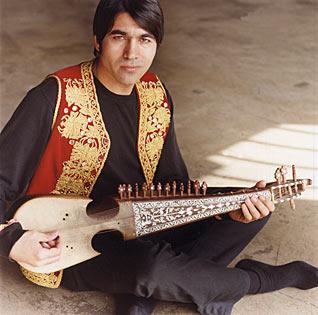Music
The Music of Mardana
Reviewed by LAURIE BOLGERA concert held at The Rubin Museum of Art, New York City on January 21, 2007
The penultimate weekend of the Rubin Museum's exhibition of early Sikh art, "I See No Stranger," featured "The Music of Mardana," a program that adroitly blended spellbinding storytelling with the mellifluous music of the rabab, the instrument played by the minstrel companion of Guru Nanak.
Quraishi (who goes by a single name only), a leading exponent of the rabab both in his native Afghanistan and the United States, delivered a most sensitively-interpreted performance, inspired by the janamsakhis of Sikhi's Guru-founder. The influence of classical Hindustani music theory could be unmistakably heard in the intricate melodies and rhythms of this Kabul-born virtuoso's soulful rabab. A lutelike instrument similar to the Indian sarod, Quraishi's rabab, made from a single piece of mulberry wood adorned with richly inlaid ornamentation, has three melody strings, two drone strings, and fifteen sympathetic strings. These are variably tuned to the ragas, or musical modes, allowing for a deeply resonant timbre and subtle alterations in tone.
This highly respected performer, who has helped to preserve and reinterpret Afghan music, as well as rekindle interest in this ancient instrument, was most ably accompanied by one of his country's top percussionists, Chatram Sahni. Sahni's double-headed Afghani drum, or dholak, is made from mulberry wood with goat skin stretched over both ends, tunable using a network of adjustable ropes.
Both Quraishi and Sahni played with considerable depth of feeling, an amazing degree of mutual rapport evident throughout all their pieces. Each seemed perfectly attuned to the other's slightest nuances of intonation and subtlest shifts in tempo, as if an intimate musical dialogue were being held between them.
It would have indeed been wonderful if they could have extended this conversation in some way to their audience. Their performance would have been greatly enhanced by their addition of some preliminary explanations and background information. Was their style taken from a particular school of Afghan music? Did it originate in a specific time period or geographical region? Were their individual selections based on strict interpretations of traditional melodies, or were they playful, modern improvisations they themselves invented?
These omissions aside, their performance not only exhibited an impressive degree of virtuosity, but also gave a tantalizingly vivid glimpse of the richness, range and variety of Afghan music.
A strong connection to Sikhi was provided by the Rubin Museum's Director of Programming, Tim McHenry. He masterfully morphed for the occasion into a consummately-skilled storyteller, engagingly relating six janamsakhis in delightfully expressive tones of voice.
Appealingly interleaved at well-timed intervals with Quraishi and Sahni's musical selections, McHenry's recountings of the classic tales were colorfully complemented by images of paintings from the exhibition, artfully selected to match each story and dramatically projected on the stage's backdrop.
The audience clearly savored the brief, but rich taste of the adventures Guru Nanak and Mardana experienced on their decades-spanning "quest for truth." Together, the pair sought a night's shelter at the dharamsala of Sajjan the Thug, outwitted a man-enchanting sorceress, were held captive in Babur's jail, and slept beside the Ka'aba Stone in Mecca. Mardana was never far from the Guru's side, even as Nanak splashed with the Hindu pilgrims at Haridwar or placated a group of Sufi pirs by placing a jasmine petal atop their brimming bowl of milk.
Skillfully studding his recitations with carefully chosen quotations from Guru Granth, McHenry made Guru Nanak and his loyal companion come endearingly alive, giving a touching look at their enduring friendship. When, in a plot variation appropriately befitting the program's geographical focus, the aging minstrel dies on Afghan soil, poignant proof is given of their unbreakable bond. As Mardana is cremated by the River Kuram, the Guru wistfully "heard the lyre play without being plucked."
All in all, "The Music of Mardana" served up a sumptuous feast -- for the ears and eyes!
Conversation about this article
1: Jaspal S. Soni (Hacienda Hts), April 23, 2007, 8:02 AM.
You would have enhanced this superbly written article by adding a video/audio clip using Utube technology. It could still be done if the musician/drummer give consent. This writeup is no small feat. It conveys a very vivid imagery of the artist's performance.



